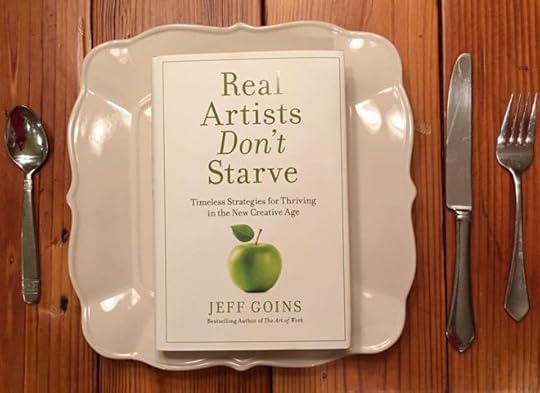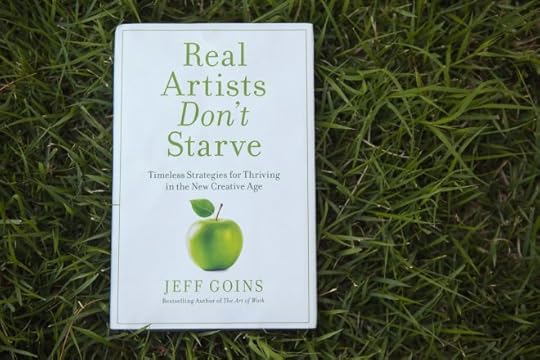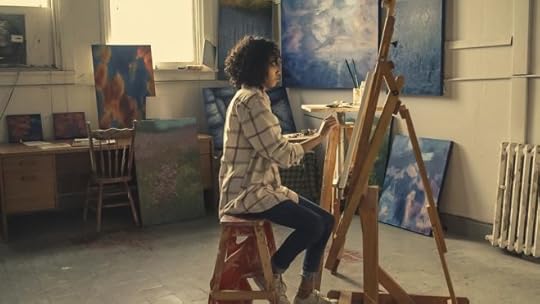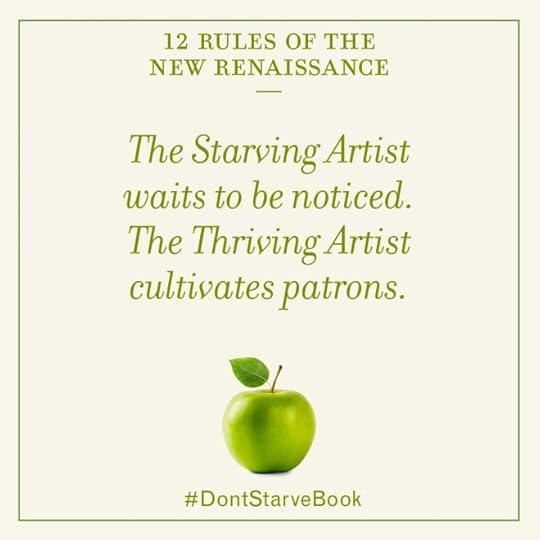Jeff Goins's Blog, page 25
June 9, 2017
What to Do When Artificial Intelligence Changes Your Work Forever
It’s in the news almost every week now – some new artificial intelligence program surprises scientists by doing something they didn’t think would be possible for a generation.
And while the possibilities for better health care, transport, and scientific breakthroughs are fascinating and inspiring, there is also going to be a huge process of adaptation for our culture.
In fact, it’s already begun at the workplace.
Take a look at manufacturing, mining, and large sections of agriculture and you’ll see millions of human jobs taken over by robots, machines, and more efficient factories. Call centers around the world are about to experience something similar.
And the economy is never going back.
The world is addicted to the cheap products these processes create, and many politicians aren’t sure how they should address the new work gaps being created.
So what do you do in a world where the job you thought you would have for the rest of your life might soon be significantly impacted by artificial intelligence or machines? And if you’re already in a technologically advanced space, how can you optimize further?
I’m no expert on the A.I. revolution, but here’s some things I’ll be trying for myself and my company. I hope it helps in some way.
What will Artificial Intelligence mean for our work?
The first thing we need to note is that no one really knows what is going to happen when it comes to artificial intelligence. Current estimates fall somewhere in between science and radical science-fiction.
Guys like Elon Musk and Steven Hawking are worried, and you can read articles like this one that suggest that A.I. will be the end of the human race, or more hopeful economic pieces like this one that suggest perhaps we won’t need to work for money soon because A.I. will do all the heavy lifting. That could be fun!
But I think the CEO of GoDaddy is a bit more on-the-money when he says that he thinks about it more practically: what is happening right now and how should people be preparing today? As such, GoDaddy is hoping to show people how to move towards a small business model that is available to almost anyone.
All of this can be a bit overwhelming and, for me at least, it’s important to remember that I can’t change the evolution of the human race or the economy as a whole, but I can have a big impact on what I do with my life, work, and income.
That’s where Jeff’s new book, Real Artists Don’t Starve, really says something interesting:
“Sometimes, it’s not the big bets that pay off but the small ones that get you the big win. If you don’t have to go all in, don’t. Why not start with a smaller risk? Most significant change begins with a simple step, not a giant leap. You don’t need to see the whole path to know what your next move is; you just need to take the next, right risk. Small changes over time can lead to massive transformation.”
“Small changes over time can lead to massive transformation.Tweet thisTweet
So what is a small risk that we can all take? Something with low barriers to entry and easy access to information, training, and results?
It’s the web.
Thinking carefully about the Internet’s role in our work’s future
The Internet has created some fantastic income opportunities for our generation that have never been available before – for many people it represents a huge lifeline.
I am eternally grateful that my whole career has been shaped by my attempts to find work online because I didn’t know what to do in the “real world” and I hated college.
And I can’t help but evangelize its benefits of the net when I see so many others frightened or confused about what to do with their own uncertain careers.
More and more people are turning to the Internet to help sell their products, services, or create something entirely new for the world.
For example, I’ve spent the last five years on Blog Tyrant teaching people the ins and outs of starting a blog and growing it strategically as a way to supplement their income in a rapidly changing economy.
Those blogs can do almost anything, and they can help you no matter what you do.
If you’re an artist, you can use a website or blog to find audiences around the world that would have never encountered you 30 years ago. You can sell to them directly with your own store made with a simple plugin, or you can use an existing website like Etsy.
If you’re a writer, you can build a massive audience that know and love your material long before you even launch a book to sell. Go one step further and encourage them to sign up to a mailing list and you’ve got an instant selling platform that the authors of the past would have killed for.
If you’re a real estate agent that is used to advertising in the newspaper alone, why not get a simple Instagram account and upload photos of your new listings with hashtags that allow you to tap into the local population instantly and for free?
These technologies are cheap, often open-source, and constantly evolving to make your job easier.
There are analytics and data programs that automatically tell you what design converts best. There are advert platforms that will put you directly in front of people who are statistically more likely to engage with your work.
And, best of all, there is limitless free education available in forums, courses, etc. for people who want to learn how to take advantage of the Internet for their own chosen niche.
What if you know nothing about the Internet?
Sure, creating a website and learning how to promote your work (or yourself) is a big step that will represent a rather large learning curve for a lot of people.
And that’s where Real Artists Don’t Starve shines another light:
“More often than not, our creative dreams aren’t launched over-night. They are built gradually. When you are in a season of life when you can’t dedicate hours a day to your craft, it can feel like you’re standing still. But at those times, when the odds are overwhelming and the busyness is suffocating, you still have something to give. The effort may seem small and insignificant, but the work adds up.”
“The effort may seem small and insignificant, but the work adds up.Tweet thisTweet
Using the Internet to start a business, promote art, network to find new clients, etc. is a long term move.
It’s something we can do after work.
It’s something we can do on the weekend.
It’s even something we can do while we go back to school to get a new qualification.
It’s not all or nothing.
But one of the most important things to consider here is that it’s the art of learning itself that is going to make a huge difference in this new age of A.I. and machine learning. While my own example is not remarkable, I am constantly amazed and the different opportunities I have found by just being online researching ways to make my current projects work.
Throughout history we can find countless examples of people who resisted change because it was scary, overwhelming, etc. and then got left behind. Unfortunately, for a lot of people who are trained and working in areas vulnerable to A.I. and automation, we are at another similar historical juncture.
Real Artists Don’t Starve encourages creatives to approach their careers differently, and this is all that we are talking about here. We can use the Internet and these new technologies to backup our careers, supplement them, and even find new income opportunities.
Whether or not you succeed right away is one issue.
But it’s important to keep in mind the big picture: the skills you’ll learn, the networks you’ll make, and the ‘believe in yourself’ attitude that somehow gets developed when you decide to take control of a difficult situation and make something of it.
Those are factors that might just help us flourish in an exciting new age.
So where do we start?
As someone who naturally has a lot of anxiety, laziness, and a habitual need to procrastinate as much as possible, the best advice I can give is this:
Just start.
While there is a lot to be said for business plans, marketing strategies, etc. there is also a lot that is learned by experimenting. If you look at successful examples in your niche you’ll almost always notice that their breakthroughs came because they were tinkerers.
Here’s some small but significant things you can do today:
Get your own modern real estate
Unless the Internet changes dramatically through concepts like removing net neutrality, then one of the best things you can do is set yourself up on your own blog hosting that will allow you to build a place online that you own and control. You can brand it, change it, and develop however you need and for whatever purpose your art or work requires. Don’t underestimate how important it is to have your name and brand easily found on Google. Google is not going anywhere.
Practice on social networking that organizes by community
If you’re not ready for that, then start practicing on platforms like Medium or Pinterest that allow you to collect things that interest you, ask educational questions, find people in your area that you might be able to copy/learn from, etc. Knowing the right people is invaluable, especially when you are starting out and need guidance.
Look at your threats and opportunities
The next thing you’ll want to do is take a look at the threats that are facing your career, income stream, ability to change jobs, etc. At the same time, you’ll want to uncover any opportunities that might be available to you because of your passions or skills. You’ll be surprised at how many “real world” skills can be brilliantly adapted to the net. Look at stories like Nasty Gal who took a passion for vintage clothes into a multi-million dollar online store, Miniature Sweet who sold over 200,000 products on Etsy in 2015, or the farmers turned web entrepreneurs on Dishing Up the Dirt. These are all examples of people who have used the net to combine with a physical business and see a new success.
Set a goal and a timeline
If you decide to make some sort of change then it can be extremely useful to set a goal and a timeline. As I said earlier, I can be very lazy and if I don’t set a goal then I end up on the research phase for all eternity. Do some reading around and come up with a realistic set of numbers like making a part time income online within two years, selling 10% more paintings on the Internet by the end of the year, or just setting up your own website and online store within a month. Again, it doesn’t matter whether you hit these targets because you learn a lot on the way and the goals often change.
Look for ideas outside of your regular industry
One of the most valuable things anyone ever told me was to look for ideas outside of your niche because there are a lot of people doing it better. For example, if traditional newspapers had embraced blogging a lot earlier on and adopted subscription models instead of ads based on traffic numbers, then they might be in a lot less financial trouble as an industry. Things like Google SEO, Facebook advertising, social media marketing, conversion optimization, etc. will benefit almost any industry, on or offline.
Find a way to be distinctive
Professor Sharp has done a lot of researching in to successful businesses and marketing campaigns and found that one of the most vital things is that you find a way to be distinctive and memorable. It’s no longer likely that you’ll be original, so find a way to stand out from your competitors and then work on reaching as many people a you can.
Solve modern problems
The last point I wanted to talk about is how important it is to be useful. The world is undergoing rapid changes in things like science, politics, religion, climate change, community structure, education, and, through all of this, people (rightly or wrongly) are looking for solutions online. Try to make sure that everything you do on the Internet helps someone, even if only in a small way. You’ll also find that they’ll be more likely to talk about you to their friends if you’ve helped them sleep better at night. This leads to a very rewarding work life for yourself and your staff.
Remember, you don’t have to do everything all at once. It’s enough that you sit down and try to learn something new. While that won’t’ pay the bills right away, it could be the start of a new stage in your life that brings you a lot of fulfillment.
A final word
Thinking about robots, artificial intelligence, and all the changes that the workplace is undergoing can seem a little overwhelming. But it’s important to remember that we now have so many opportunities that weren’t possible even just a few years ago.
If you’re on this website it’s pretty likely that you’re more creative, driven and curious than average and, as such, you’re already at a huge advantage.
So what will you be doing differently in the age of A.I. and robotics? And are you already using the Internet to supplement, enhance, or backup your career? I’d love to hear your thoughts and ideas below in the comments.

June 7, 2017
Tough Questions About Real Artists Don’t Starve
You can’t write a book called “Real Artists Don’t Starve” and not expect a reaction. If you try to write for everyone, no one will pay attention. With my latest book, readers are asking some tough questions.
This week on The Portfolio Life, Andy rejoins us to cohost this special episode as I sit in the hot seat to answer a few pointed and insightful questions about Real Artists Don’t Starve, the myth of the starving artist, the steps it takes to thrive as a creative, and the rules of New Renaissance.
Listen in as we discuss the nature of creative work, the importance of joining a scene, Steve Jobs impact at Apple, a poignant lesson from George Lucas’ early days with Star Wars, and why starving doesn’t lead to great art.
Listen to the podcast
To listen to the show, click the player below (If you’re reading this via email, please click here).
Show highlights
In this episode, we discuss:
Addressing the perception of survivorship bias
Supporting yourself without selling out
Why making money leads to making more art
What Picasso, Hemingway, and Jim Henson have in common
How the story we tell ourselves about art impacts our craft
Why artists sometimes starve, but don’t have to
The role geography plays in your creative success
Looking for the existing opportunities available to you
The balance of maintaining ownership and selling your work
How to decide between traditional publishing and self-publishing
One thing I’d love every person who reads the book to tell me
Quotes and takeaways
Go where the magic is right now. Join a scene or create one.
Art costs money. Art costs time. The best art does not come from scarcity.
If you don’t want to do marketing, you can’t be upset that nobody’s looking at your art.
You might be standing in your own way.
Throughout history, real artists didn’t starve to create their best work.
“Genius is a group effort.Tweet thisTweet
Resources
Real Artists Don’t Starve
The Geography of Genius by Eric Weiner
Group Genius by Keith Sawyer
Make Art Make Money by Elizabeth Hyde Stevens
Click here to grab your copy of Real Artists Don’t Starve.
Do you think artists have to starve for their work? What does a thriving artist look like to you? Share in the comments

June 6, 2017
Real Artists Don’t Starve is Now Available (Last Day for Bonuses!)
Today, my new book Real Artists Don’t Starve hits bookstores everywhere. Which means today is your last day to get some amazing bonuses when you order the book.
Here’s where you can order the book (in convenient, alphabetical order):
Amazon (available in hardcover and on Kindle)
Audible (free trial for non-members)
Barnes & Noble
CBD (current lowest price!)
Google Play
iBooks
Indiebound
I’m doing a happy dance right now (well, more like a happy bounce-in-my-chair), because I spent over a year researching this book and another 11 months writing it. Today is the day that book gets to see the world. That feels pretty good.
With historical examples and contemporary case studies, this book will help you:
Debunk the myth of the Starving Artist and believe a better story.
Harness your creativity as a weapon to help you overcome your creative battles.
Thrive in your creative passions so that you can make a living off your “art.”
To all of you — and there were thousands — who supported RADS by pre-ordering it, thank you! Your copies should be arriving in the mail soon (maybe even today). (Note: Some books may not ship internationally until later in the year, but eBooks and digital audiobooks are available now.)
But!
It’s not too late…
Last day to get bonuses
For those who missed the pre-order bonuses (and there were some snazzy ones), today is the LAST DAY to order the book and get those bonuses. Here they are again:
Bonus #1: Real Artists Don’t Starve Online Course ($99 value): a 12-part video course on how to make a living off your art. This is a full-fledged course you won’t want to miss.
Bonus #2: Expert Interviews ($49 value): PDF transcripts of ALL the experts and Thriving Artists I interviewed during the research of my book.
Bonus #3: Exclusive Community ($49 value): Special access to a private Facebook group where I will answer your questions regularly and you can connect with others reading the book. There’s already over 1000 people here who are sharing their work and getting help on projects.
EXTRA LAUNCH DAY BONUS: Real Artists Don’t Starve Study Guide ($19): Today, I’m adding a brand-new study guide that I just created that you can get when order the book today.
After today, these bonuses go away. You’ll actually have to buy them separately instead of getting them included with the book. So don’t miss that. You have until midnight to get the book and grab those bonuses. You can pick up the book in any format from any retailer.
All you need to do is:
Buy the book in any format (yes, any format, anywhere).
Forward your receipt to rads@goinswriter.com.
Check your email to receive the bonuses.
That’s it!
Order the book right here, right now.
But is this book for me?
Buying a book is a big time commitment. I get that. If you’re not sure if this is for you, here is what some people smarter than me have to say about it:
“Jeff Goins doesn’t just show us how to be more creative. He also reveals a path for turning our art into business and our business into art. Every entrepreneur, writer, and artist should read this book and take notes.”
–Daniel H. Pink, author of Drive and To Sell Is Human
“Jeff Goins is back with his most powerful book yet. Every page offers insight, hope, and practical advice for anyone who wants to make their dent in the universe.”
–Seth Godin, author of Linchpin
“Jeff Goins has established himself as a fresh and dynamic voice inspiring us to get out of our own way and produce our best work. Real Artists Don’t Starve is the work of angels: a book every aspiring writer, artist, and creative must read.”
–Steven Pressfield, bestselling author of The War of Art
“Anyone trying to make a living from their creative work will find much to steal here.”
–Austin Kleon, author of Steal Like an Artist
“Goins dispels the myth that being a creative is some illusive, mysterious dimension reserved for a chosen few. Instead, he reminds us that being an artist is a job that any motivated person can do with a strategic focus on inspiration-gathering, collaboration, risk-taking, discipline, and marketing.”
–Lisa Congdon, artist and author of Art Inc
FAQ’s
I’ve received a few questions about the book that I want answer here:
“Did you write this whole book yourself?”
Well, nobody actually asked this, but yes, yes I did. Actually, I did get some great help from a few people on the editing side of things, which I share in the Acknowledgements.
Is there an audiobook?
Sure is. And it’s read by someone (not me) who’s voice doesn’t crack every other word. He did a good job. You can order the audiobook on Audible. If you’re not a member, you’ll get the book for free if you sign up through my special affiliate link by clicking here.
“I’m not an artist. Is this book for me?”
Well, first of all, I think we all have creative gifts to share with the world. Which, in a sense, makes us all artists. I wrote this book for anyone who fits that description — including visual artists, writers, speakers, creative entrepreneurs, photographers, bakers, crafters, calligraphers, culinary artists, and so many others. This isn’t a book for everyone, but it certainly is a book for anyone who wants to be more creative and use that creativity to make a living.
“Are you saying that if I’m starving, them I’m not a real artist? Isn’t that offensive?”
The argument of the book is that you don’t have to starve. Starving as an artist is a choice, not a necessary condition of doing creative work. I consider the title a dare. It’s saying, “Are you a real artist? Then DON’T STARVE!”
“Aren’t you just highlighting the success stories?”
The research I did consisted of reading hundreds of biographies of artists, authors, and entrepreneurs, and then comparing what I found to hundreds of interviews I conducted with groups of both successful creatives and unsuccessful ones.
In the book, I lay out the 12 lessons I learned from this research. When followed, these strategies help creative people succeed. When ignored, you’re leaving your fate up to chance. I don’t think most creative success is a matter of luck, and in this book I attempt to prove that. Whether or not I do that successfully is up for you to decide.
Can I order the book for my team or organization? Can I give it to friends?
Yes, you absolutely can. If you order 3 or more copies, you’ll get additional bonuses. If you do that today, they can get the bonuses as well. For more about bulk orders, fill out this form.
Order the book today!
Amazon (available in hardcover and on Kindle)
Audible (free trial for non-members)
Barnes & Noble
CBD (current lowest price!)
Google Play
iBooks
Indiebound
Don’t forget: If you buy the book today and forward your email receipt to rads@goinswriter.com, you can claim $216 in bonuses. Thanks!
Do you know a starving artist who you want to see thrive? Why are you excited about this book? Share in the comments.
Photo credit: Paul Turner

June 5, 2017
Only One More Day to Get $200 in Bonuses for My New Book
Just to remind you, here are the bonuses:
Bonus #1: Real Artists Don’t Starve Online Course ($100 value): a 12-part video course on how to make a living off your art.
Bonus #2: Expert Interviews ($50 value): PDF transcripts from the dozens of experts and creatives Artists I interviewed during the research of my book.
Bonus #3: Exclusive Community ($50 value): Special access to a private Facebook group where I will answer your questions regularly and you can connect with others reading the book.
To claim these bonuses:
Buy the book at (Amazon, Barnes & Noble, Indiebound).
Forward your receipt to rads@goinswriter.com.
I’ll send you the bonuses.
That’s it!
Remember, $200 in bonuses go away completely TOMORROW. Don’t miss out!

June 2, 2017
The Real Reason Why Creatives Can’t Make Money Off Their Art
The title of my new book, Real Artists Don’t Starve, has gotten some pushback from people who have been told their whole lives that creatives can’t make money off their art.
But is that true? Do you HAVE to starve to be an artist?
I want to set the record straight and in order to do that, I’m going to need your attention. So, I’m hosting a live video training just for you.
What: 3 Creative Ways to Make Money Off Your Art
When: June 2 @ 1:00pm Central (US & CAN)
Where: Click here to register for free
In this free training, I’ll share three strategies on how to make a full-time living off their art. You’ll learn:
The best way to get major influencers in your industry and niche to do the marketing for you
The secret to charging what you’re worth (and how to price your products and services so that they sell)
The multiple income streams you need to make a full-time living off your art
These strategies apply to any creative field, including visual art, writing, music, and just about anything else you can think of. If you have a gift to share with the world, I’ll show you how to get it out there and make a living off it!
Click here to register for the live training and claim your seat.
Do you think creatives should make money from their art? Why or why not? Share in the comments.

May 31, 2017
154: Vocation and Identity: Interview with Dan Cumberland
It’s endlessly frustrating when you don’t enjoy the work you’re doing while wondering what you’re really called to do. But maybe many of us have been thinking about vocation all wrong.
Some people miss their purpose in life and continue to go through the motions of life until they take the aching in their heart to the grave. As Henry David Thoreau once said:
The mass of men live lives of quiet desperation.
But what if your calling was right under your nose? What if it wasn’t something you were obligated to do, but something you freely enjoyed? This week on The Portfolio Life, our guest coaches people through the process of discovering meaning in their life and work.
Dan Cumberland proposes that while calling is about identity and work, it does not contain the whole of who we are and the meaning we bring to the world. Listen in as Dan and I talk about the definition of vocation, the pitfalls of external pressure, and why you may not be surprised by your life’s work.
Listen to the podcast
To listen to the show, click the player below (If you’re reading this via email, please click here).
Show highlights
In this episode, Dan and I discuss:
What does calling mean
Unpacking what it looks like to coach people to help them find their calling
Struggling with comparison to high achieving family pressure
Pursuing ministry as a vocation and discovering it wasn’t a fit
Why a calling isn’t like getting struck by lightning
How to stop waiting for an epiphany and discover your calling
Finding alignment between what you do and what is meaningful for you
Imagining what it looks like to have fun in your work
Breaking down the dichotomy of arguments around calling
Rejecting the traditional models of a calling
Landing a client while working at a pizzeria
The four progressive steps of exploring your calling
Why most people are not surprised by their calling
A big obstacle that keeps many people from finding their calling
The gap between what you want to do and what you’re actually doing
Quotes and takeaways
If you hate your calling, it’s not your calling.
Your calling is something you choose to do, accept, and enjoy.
“Grow and increase the things you’re doing that already bring meaning into your life.” –Dan Cumberland
“The words we use to describe something shape our experience of it.” –Dan Cumberland
“How you tell the stories that shaped you profoundly impact the way you think about who you are.” –Dan Cumberland
“Your calling is so much bigger than any one job can contain.Dan CumberlandTweet thisTweet
Resources
The Meaning Movement
The Calling Course
Let Your Life Speak by Parker Palmer
The Art of Work by Jeff Goins
Podcast sponsor: Real Artists Don’t Starve
Download the transcript here (pending)
What stories are you telling yourself about your calling? How does the prospect of enjoying your work change how you think about calling? Share in the comments.

May 29, 2017
Why Creatives Need to Leave Their Comfort Zones
Since my new book Real Artists Don’t Starve is coming out soon, I wanted to share with some of my favorite parts from the book.
Here’s the next lesson:
The Starving Artist works alone.
The Thriving Artist Collaborates with others.
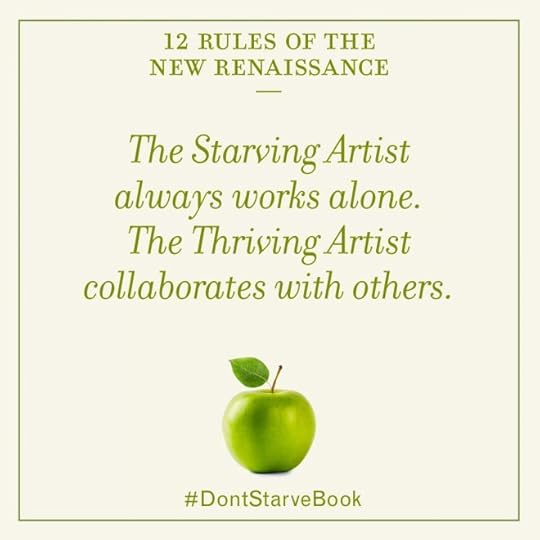
Creativity never happens in isolation. It’s almost always a collaborative creation.
No one better illustrates this than the friendship of two of my favorite authors: C.S. Lewis and J.R.R. Tolkien.
“There was a group of them,” Diana Glyer told me, “nineteen men, and they got together once or twice a week for about seventeen years. And in those meetings, there was a special kind of
magic that happened.”
“Creativity never happens in isolation. It’s almost always a collaborative creation.Tweet thisTweet
Glyer teaches English at Azusa Pacific University and has dedicated much of her career to the study of the Inklings, the literary group that included J.R.R. Tolkien, C.S. Lewis, and their friends. Professor Glyer told me how they met for decades once a week over tea and pipe smoke.
“They read their works in progress to one another,” she said, “and they stayed up late into the night giving each other critiques… And it is in this forge of friendship and engagement that some of the great works that we love were created.”
But for a long time, many people had no idea the Inklings were influencing each other’s work in such profound ways. Among the many examples Professor Glyer cited of how these men influenced each other’s work, one in particular stood out.
After the unexpected success of The Hobbit, J.R.R. Tolkien’s publisher asked him to write another novel. As he began writing what was then called The New Hobbit, he got stuck only a few chapters in.
One day he asked his friend C.S. Lewis to lunch and admitted to feeling bored with the project. “I don’t know what to do,” Tolkien said. “I think I’m done.”
“The problem,” Lewis replied, “is that hobbits are only interesting when they’re in unhobbit-like situations.”
That was all he needed to say.
“So,” Glyer explained, “because of one lunch with a buddy, the story where Tolkien was basically done and directionless, one comment opens up the vista and gives us what we now know as this wonderful, rich epic story, The Lord of the Rings. I think that’s pretty strong evidence of influence.”
With one little comment, C.S. Lewis changed the direction of what would become his friend’s greatest work. As Lewis himself once wrote, “The next best thing to being wise oneself is to live in a circle of those who are.”
The same, it seems, can be said for being creative. We don’t do our best work alone; we do it by collaborating with others.
“We don’t do our best work alone; we do it by collaborating with others.Tweet thisTweet
Real Artists Don’t Starve comes out soon. If you pre-order the book before then, you’ll get a 12-part online video course, expert interview transcripts, and access to a private community. All you have to do is:
Buy the book at (Amazon, Barnes & Noble, Indiebound).
Forward your receipt to rads@goinswriter.com.
I’ll send you the bonuses.
Click here to download the full excerpt of Chapter 7: Collaborate with Others from Real Artists Don’t Starve.

May 24, 2017
153: Why Meaningful Work Automatically Attracts an Audience: Interview with Mark Frauenfelder
One of the biggest challenges any creative faces is what to make and who to make it for. How do you determine if an idea is a good fit for you, or if anyone will pay attention?
Being a full-time writer doesn’t necessarily equate to writing “full-time”. I don’t sit at my desk for eight hours every week day and pound away at the keyboard writing books and blog posts. There’s a bit more complexity to running a successful blog, launching books, and operating a digital business.
However, and more importantly, I’m interested in more than just writing from both a professional and personal standpoint. I enjoy speaking, drinking great coffee (not from Starbucks), reading, making guacamole, singing karaoke, playing with my kids, and travel among other things.
But I don’t write about all of these topics because that would be confusing to even the most loyal reader.
So how do you decide what to pursue when you feel bombarded by ideas and a collage of interests?
This week on The Portfolio Life, our guest is a modern day polymath, and basically created the Internet as we know it today (at least in my book). He’s been involved in magazine publishing since the 80’s, served as the Editor in Chief of Wired.com, started a podcast network, unknowingly cofounded the Maker movement, and designed a Billy Idol album cover.
Listen in as Mark Frauenfelder and I discuss the theme of his creative pursuits, why he doesn’t work on anything that doesn’t pique a personal interest, and how he came to write a how-to book on card tricks.
Listen to the podcast
To listen to the show, click the player below (If you’re reading this via email, please click here).
Show highlights
In this episode, Mark and I discuss:
Starting a print ‘zine in the 80s
Getting recruited by Wired
Taking a ‘zine digital in the 90s
How his editor thought blogs weren’t going to be viable
Identifying the common thread through diverse experiences and interests
Avoiding being a jack-of-all-trades while embracing opportunities to explore
Dealing with the tension between daily life and a creative career
The origins of the Maker movement
Why some comics are unreadable
What artistic style he subscribes to
Quotes and takeaways
“Make sure you give yourself time to do deep work.” –Mark Frauenfelder
Pursue work that is personally meaningful to you and an audience.
Embrace new ideas you enjoy, but stay grounded to a common theme.
“Try not to fall in love with your first idea.Mark FrauenfelderTweet thisTweet
Resources
Vellum writing software
Wired.com
Trick Decks: How to Hack Playing Cards for Extraordinary Magic by Mark Frauenfelder
Real Artists Don’t Starve
Download the transcript: pending
What is the theme of your creative work? How can you combine your interests to make something meaningful to others? Share in the comments.

May 22, 2017
The Real Person Responsible for Creative Geniuses
Along with the bonuses that come with preordering my new book, I’m sharing some of my favorite lessons from Real Artists Don’t Starve. Here’s the first:
The Starving Artist waits to be noticed.
The Thriving Artist cultivates patrons.
When we see someone succeed with their art, we often chalk this success up to luck. But is that what’s really happening?
At the same time, was it just talent that allowed them to succeed?
Behind most creative geniuses, there is an invisible influencer making it all happen. These people lend their influence to help creative talents succeed, introducing them to people and opportunities they would not encounter otherwise.
The Rule of the Patron
Before you reach an audience of many, you must first please an audience of one.
Every artist needs a patron. Without one, your success becomes exponentially more difficult; with one, it becomes not only possible but probable.
Starving Artists disdain the need for patrons. It feels disempowering, even beneath them.
On the other hand, Thriving Artists respect the Rule of the Patron and use it to their advantage. All creative workers need influencers who will vouch for them to an audience who doesn’t know them yet. But it is not enough to meet a patron; you must cultivate one.
The publisher who pays an author’s book advance is a patron. The venture capitalist who funds a startup in Silicon Valley is one too. But so is the church who gives a minister a salary or the donors who support nonprofit organizations around the world.
Patrons do not just make the arts possible; they make the world we inhabit—and so often take for granted—possible. Our job isn’t to wait for patrons to come to us but to find and cultivate these relationships, wherever they may be.
“Patrons do not just make the arts possible; they make the world we inhabit possible.Tweet thisTweet
So, where are today’s patrons? Do they even exist anymore? In the New Renaissance, patrons are not some elite class of influencers. They are all around us.
The budget of a band
My first year out of college I traveled across North America playing music with a band. As the group’s leader, I oversaw setting up gigs ahead of time, coordinating with event planners and hosts, and making sure everyone arrived at the show on time.
It was a lot of hard work, long days, and cold casseroles. But one factor made the work possible: the fact that we didn’t have to do it alone.
Moving from city to city, our band would play shows in exchange for donations and meals; we were always at the mercy of other people’s generosity. Wherever where we went, we met someone who would make sure we found a good meal, warm bed, and sometimes even a hot shower.
For a year, we lived off the good nature of other people, staying in their homes and eating their food, getting to make our art. Everything we did that year cost something: the gasoline for the van, the meals on the road, the occasional night in a hotel when we couldn’t find a host home.
It all had to be paid for by someone.
My six bandmates and I didn’t have to worry about any of that, though, because there were people concerned about those things for us. They paid our bills and took care of our expenses; they hosted events for us and took us into their homes.
These people were our patrons. They were not wealthy connoisseurs or influential leaders. They were ordinary people who used their resources to help our art thrive. Certainly, there can be value in connecting with an influential tastemaker, but sometimes, the patron you need is the person right in front of you.
It’s our job to recognize them and prove ourselves worthy of their investment.
May you do just that.
To download a free excerpt of the Cultivate Patrons chapter from my book, click here.
Real Artists Don’t Starve comes out soon. If you preorder the book before then, you’ll get a 12-part online video course, expert interview transcripts, and access to a private community.
All you have to do is:
Buy the book at (Amazon, Barnes & Noble, Indiebound).
Forward your receipt to rads@goinswriter.com.
I’ll send you the bonuses.
How does The Rule of the Patron apply to your craft? Who is someone that has supported your art? Share in the comments.

May 17, 2017
152: The Truth Behind Finding Luck: Interview with Brett Kelly
People start writing for all kinds of reasons. Fame, fortune, boredom, or another hobby they’ll quit in three weeks. But sometimes, a person writes for something more.
They write for freedom.
Most of us want freedom from something. Our past, a bad habit, a toxic relationship, a dull day job, or even the distractions we let keep us from writing.
Our guest this week on The Portfolio Life, was living somewhat comfortably, but wanted freedom from debt. Over the years he’d developed close relationships with a small circle of friends who ended up being quite influential.
He knew Chris Guillebeau before The Art of Non-Conformity was published by Penguin. He knew Leo Babauta when Zen Habits was on a blogspot domain. Our guest saw his friends writing online and creating digital resources for their audiences and wanted to do the same.
So, Brett Kelly took one of his favorite productivity tools and wrote a robust user guide called Evernote Essentials. With the blessing of Evernote, the support of his friends, and the attention of people like Michael Hyatt, Brett has sold nearly 80,000 copies of Evernote Essentials.
Listen in as we discuss how Brett launched with a list of 400 people, losing track of how many tattoos he has, and how the CEO of Evernote personally recruited him.
Listen to the podcast
To listen to the show, click the player below (If you’re reading this via email, please click here).
Show highlights
In this episode, Brett and I discuss:
Debt freedom as a motivator to create
Paying attention to market trends
Not getting sued by Evernote
Broadening creative horizons and diversifying personal brand
The awkwardness of explaining what you do as a creative to people who care, but don’t “get” it
The ambiguity of calling yourself a writer
How running a business around your writing is like fixing a plane mid-flight
Accidentally building a cadre of friends who ended up being very influential
Distilling complexity into something digestible for the masses
Quotes and takeaways
Sometimes humility isn’t very helpful when people are looking to you for answers.
Be helpful. Be encouraging.
“People who had more than I had, gave to me. That’s why I’m here.” –Brett Kelly
The medium of creation effects the final outcome.
“Be cool to people.Brett KellyTweet thisTweet
Resources
Evernote
Evernote Essentials by Brett Kelly
Michael Hyatt’s system for organizing Evernote
OmniFocus
Getting Things Done by David Allen
Interview transcript: coming soon
What is your favorite app to write in? What is your “superpower” or the theme of your work? Share in the comments




